Priyanka Nair (Joshi)'s Blog, page 12
August 30, 2022
Support Your Employees’ Mental Health By Adopting These Practises at WorkPlace
The consequences of the worldwide pandemic left a decline in mental health among many workers. Along with handling personal problems, worry, stress, and burnout in the workplace are common factors. According to research, one in five US individuals suffers from a mental disorder, yet fewer than half receive treatment.
Mental Health in the Workplace Summit also stated that mental health issues are the leading cause of absenteeism than any other injury or illness.
 6 Strategies To Support Your Employees’ Mental Health
6 Strategies To Support Your Employees’ Mental HealthThese statistics prove that organizations must create a positive work environment that acknowledges their employees’ mental health. While many employers are now incorporating mental health benefits into their organization, making it a must rather than a perk, some are still navigating this concept. But with the right approach, understanding what you can do to deliver programs for your employees can be easy. Here are six strategies for HR to support employees’ mental health.
Create a Healthy Workplace CultureA positive and healthy workplace culture contributes significantly to your employees’ mental wellness. There are still a lot of stigmas involving mental health that many employees fear speaking up about what they’re going through. That’s why leaders need to create and maintain a support structure that will make their employees feel safe and that they belong to the organization personally and professionally.
You can start by providing resources to encourage your employees to discuss mental health openly. For example, counseling reimbursement benefits, creating social groups that regularly meet so they can build bonds with teams, or a portal where employees can easily reach out to HR if they need help. It could also be as simple as paid time off to see a counselor or permission to go for walks to unplug for a moment. This way, you’re not only promoting to end of the stigma concerning mental health, but you’re also helping your employees to be easily engaged and productive in their roles.
Offer a Flexible SchedulingOne of the common reasons for employees’ mental exhaustion and burnout is the lack of work-life balance. Allowing for flexibility can help reduce stress and boost productivity and job satisfaction. Workplace flexibility can take the form of extended breaks, available paid time off (PTO) policies, flexible start and finish dates, or the ability for employees to telecommute a few days each week.
Additionally, managers should urge their staff to take vacation days as it may reduce the possibility of staff burnout. A company may establish a workplace where people
are motivated to bring their best selves to work if it is open to developing relationships with them.
Listen to Your EmployeesBeing a good listener shows your staff that you value them, care about their needs, and have their best interests in mind. Good listeners are attentive and involved. They speak positively, use culturally acceptable body language, and keep their electronics out of sight. Additionally, good listeners ask brief yet pertinent clarifying questions. And when someone summons the bravery to approach you with a problem, they swear never to reveal the private information of others unless someone is in danger.
You won’t have all the answers, and that’s okay. Good listeners must be at ease at taking accountability for the things they don’t know. Your presence and focus are enough to make your employees feel valued.
Provide Mental Health ServicesA company’s resource allocation and investment practices reveal its goals. Because they do not perceive a return on investment, many businesses are reluctant to engage in mental health services; yet, the quality of their employees’ work suffers due to their personal and occupational issues. More importantly, a company’s failure to address the subject of mental illness fosters a climate of mistrust and dread in the workplace.
Think about providing free access to onsite mental health counselors, entertaining team-building exercises, interactive webinars, discounts on massages, and even free video conversations with mental health specialists or therapists. In return, your organization will see tangible results, such as a decrease in absenteeism and an increase in productivity. It may also help attract quality candidates and create a healthy and trusting company culture.
Raise Awareness Among LeadersHR should prioritize educating executives on the significance of workplace mental health. After all, the more informed they are, the better it will be for the workers and the company. Leaders establish the standard for what should be acceptable and what shouldn’t be. Hence, it is essential to activate them to avoid the possibility of increasing turnover.
Provide mental health training so leaders can recognize signs of mental illness, excessive stress, bullying, and fatigue in the workplace. Additionally, they must know different ways to communicate with employees concerning their mental health. Keep in mind that if leaders do not foster a friendly workplace atmosphere, people will be afraid to open up.
Model Healthy BehaviorsIt is not enough that you support mental health. It would be best if you also modelled healthy behaviors so that your team members may feel it is okay to prioritize self-care and set boundaries. Use your paid time off for vacation, keep your camera off during meetings, or not respond to work-related calls and texts after your shift. This way, you are showing your employees that putting their mental health first is essential, and taking a rest once in a while is encouraged.
Whether they arise at work or elsewhere, mental health problems are unavoidable. However, if HR leaders lead with kindness, empathy, and openness, you will not only improve your workers’ disposition but also have a long-lasting good effect on your business.
Remember that it’s okay to go through difficult times, and talking about your anxieties and worries is also acceptable and encouraged. With these tips, we hope you can create a workplace culture that accepts and supports mental health issues.
August 21, 2022
Can You Quit Social Media to Protect Your Mental Health and Well-being?
Three in ten young people say they can’t quit or limit time on social media,
even if it improves their physical and mental health.
Young people are now three times more likely to connect with friends online than they are to meet up in person, according to a new survey by teenage mental health charity stem4 to mark Youth Mental Health Day (19 September).
But lack of social connections in the real world, and pressure to look and behave a certain way online, have left half (50%) of young people saying they lack social confidence, and that anxiety and fear of rejection are holding them back from making new friends.
Two-thirds (63%) of young people say they now go on social media every day to connect with friends. This is while just one in three (28%) meet up with friends in person daily, four in ten (39%) weekly, and one in five (23%) monthly.
Can you quit social media to protect your mental health and wellbeing?On Sunday, 26-year-old actor Tom Holland announced he had taken a social media break as social media apps had become “detrimental” to him as he would continue to read things about himself online and “spiral”.
But unlike Tom, a third (32%) of the young people told the survey they are unable to limit or reduce the amount of time they spend online, even if it would mean achieving better overall physical and mental health.
“There is an awful stigma against mental health and I know that asking for help and seeking help isn’t something we should be ashamed of,” the Spider-Man actor added.
Of the 2,007 young people surveyed ahead of Youth Mental Health Day, nearly half (46%) say they are currently experiencing mental health difficulties, of which three in ten (30%) have not had the courage to ask for help. These difficulties are often compounded by feelings of loneliness (44%), being left out (39%), and isolation (33%) either all or most of the time. This has led many (44%), young people, to say they are struggling to make and maintain friendships.

Shining a light: Youth Mental Health Day, 19 September
stem4’s Youth Mental Health Day (YMHD) will this year take place on Monday 19 September, and the theme is #ConnectMeaningfully. Over the past few years, young people have had to experience many of their most formative experiences virtually—from joining a new school/college/university to celebrating a ‘big’ birthday.
Dr Nihara Krause, Consultant Clinical Psychologist and CEO and Founder of youth mental health charity stem4, commented:
“The impact of the pandemic on social connections has had a long-reaching effect. Social media can be a force for good, but what this survey finds is that there needs to be more balance in young people’s lives. Social media shouldn’t be used as a replacement for positive connections in the real world. What is positive from this survey, is that young people say they want to make meaningful relationships.
However, they are being held back by a fear of rejection and a lack of knowing how to make connections, particularly as they have missed out on two years of social experiences and of developing social confidence post-pandemic. We want to change this by encouraging everyone to provide young people with opportunities starting with YMHD. This includes having meaningful peer and family conversations.”
By focusing on the importance of meaningful connections and having a solid support system, this year’s YMHD will invite young people across the country to reflect on how their relationships (with family, friends, educators etc.) have changed over the past few years. stem4 has created a number of resources (including for educational establishments) and is asking everyone to share ideas and set goals of how young people can #ConnectMeaningfully, to ensure they are fostering relationships that will support and positively impact their mental health.”
As reported by Penny Lukats
About the young people’s survey
A Survey of 2,007 regionally representative young people aged from 12 to 21 was carried out Survey Goo between 15th and 19th July 2022
About stem4
stem4 is an award-winning charity that supports teenagers with their mental health. It provides evidence-based education, builds resilience, enhances motivation to change, and provides signposts to ensure early intervention and action. stem4 focuses on commonly occurring mental health issues in teenagers including eating disorders, anxiety, depression, self-harm and addiction.
The charity works with students, parents and teachers in secondary schools and colleges, and with health professionals such as GPs and school nurses through its conference programme and through its digitally delivered workshops suitable for PHSE in schools. stem4 is also included in the Royal College of GP toolkit.
■ stem4’s free, evidence-based, smartphone apps
With children and young people experiencing difficulty and long waiting times in accessing effective treatments, stem4 has developed four NHS-approved smartphone apps, all based on evidence-based strategies, to help young people in the treatment of and recovery from their mental health difficulties. These apps have been downloaded and used over 2 million times. These apps include
– Clear Fear, which uses the evidence-based treatment of Cognitive Behaviour Therapy (CBT) to help manage the symptoms of anxiety;
– Calm Harm, which uses the basic principles of evidence-based therapy, Dialectic Behaviour Therapy (DBT) to help manage the urge to self-harm;
– Move Mood, which uses Behavioural Activation Therapy to help improve low mood and manage the symptoms of depression;
– Combined Minds, uses a Strengths-Based approach that has been shown to be effective in recovery, providing practical strategies for families and friends to support teenage mental health.
For information on stem4’s Youth Mental Health Day please visit youthmentalhealthday.co.uk for stem4’s full range of downloadable resources or follow @stem4org on social media to keep up to date.
August 15, 2022
What is Family Counselling and Why There is No Shame In Seeking Help?
Family counselling is exactly how it sounds: psychological counselling involves family members to help resolve internal conflicts and improve communication. Whether conducted in an office, at home, or on Facetime, family therapy should be performed by a licensed therapist or a clinical social worker. A list of the best family therapy sites can be all you need to get started.
There’s a common adage that we can pick our friends, but can’t pick our family. It’s common to have relationship difficulties within families, but unlike friends, they’re harder to cut out. Rightly or wrongly, we feel the need to spend more effort into maintaining or ‘fixing’ our family relationships because it’s deemed the most important thing in life.
Situations Where Family Counselling Could Be BeneficialThe first scenario in which family therapy is used is when there’s currently a difficulty in communicating with family members, be it siblings, parents, or in-laws. Many feel like they are disconnected from them, and therapy helps with communication. Family counselling will not only “force” a conversation because a lack of communication is a common issue, but they will somewhat mediate and help give everyone a voice.
This is equally as useful when there’s a negative atmosphere in the home. A negative atmosphere shouldn’t just be the unacknowledged elephant in the room.
Another common scenario to seek out family counselling is when there’s a bad relationship with the in-laws – a long-running joke in many communities. But, it’s no laughing matter when it becomes a serious issue and impacts the relationship between the couple – for example, arguing over where to spend Christmas or reluctance to visit family members.
Many people just get on with their in-laws not liking them. Counselling could help work out what exactly causes the negativity from both sides, and what could be done to improve it. Inevitably, the awkwardness could feel unbearable, but suggesting family counselling in and of itself can show good intent – that you’re willing to work on improving the situation, which is a big thing.
Another scenario is if the family has gone through a traumatic experience, such as a death in the family, a divorce, or some other kind of family drama that would make the relationship in the whole family difficult. Grief counselling and marriage counselling go hand-in-hand and often overlap with family therapy.
Finally, family therapy is often used when there’s a problem with someone’s mental health in the family. For example, a father with an alcohol addiction or a child with schizophrenia. Individual therapy is always recommended for the subject in question, but family therapy is commonly effective as a supplement to the individual, as well as helping other family members. It can bring a stronger structure to the family and give the chance for members to express how much the subject in question matters to them in regards to getting treatment.
 Advantages of Family Counselling
Advantages of Family Counselling Many ask, is family therapy effective? Here is a list of well-documented advantages to getting family therapy:
Strengthening relationships. Family therapy is well documented in how effective it is at strengthening relationships between family members through communication.Improved communication. Individuals in the sessions can learn better ways of communicating generally, as well as specific tips to help speak to each otherHelps when dealing with trauma. Trauma can be both devastating and tricky, which is why a professional is recommended when working through it.Understanding each other’s needs and wants. Therapy sessions can give each other a chance to express their wants and needs in a safe space with a mediator.Working through hardship together (divorce, death, etc). Therapy is useful when going through hardship, but hardship is often endured by more than one person, which is why family therapy can be particularly targeted and helpful.Improving emotional intelligence. Understanding other family members better can improve your overall emotional intelligence, which carries through into other areas of your life (i.e. work, future children).Co-parenting successfully after a breakup. Family therapy can be a way to help kids understand their new family structures and talk through sudden changes in parenting roles.Some cons of Family TherapyBelow is a list of potential limitations and downsides to family therapy.
Cost. Therapy can be costly (particularly traditional therapy), and insurance may not always cover it. Even with co-pay, it can be too much for some families – even more so if finances are the source of their relationship problems. Family counselling online could be a solution to this as it’s cheaper.Emotionally challenging and intense experience. Exposing your family to your negative feelings or trauma that they may not know about can be challenging. Whilst we should trust a licensed therapist, unearthing bottled-up feelings can be intense and tricky. Getting worse before it gets better . There might be a temporary increase in awkwardness, negativity, or fights. This is because bottled-up issues are brought to the forefront and conflict can ensue from the sessions. Of course, this is supposed to be a short-term downside, a necessary challenge, before issues are dealt with properly and we become better off in the long run because of it. But, we are under no guarantee that family members will continue sessions for the long haul.Final WordTherapy may or may not still have a stigma, but one thing is for certain: its effectiveness is not controversial. If it wasn’t for money, everybody would be recommended to get therapy, but it is clear that not everybody can. Whilst it can be challenging at times, particularly at the beginning, family therapy shows time and time again that even the most dysfunctional of families can improve their relations, or at the very least, their communication with one another. This is perhaps why online therapy has become so popular in the past few years. Lockdowns pushed many into depression, and it was only the online apps that were offering an affordable service to help.
July 30, 2022
Carved by Fire by Akshaya Saraf- Book Review
Title: Carved by Fire
Author: Akshaya Saraf
Publisher: White Falcon Publishing
Publication Date: 22 Dec. 2021
Pages: 250 pages
Rating: 4.5/5
Buy at: Amazon
I recently stumbled upon “Carved by Fire” written by Akshaya Saraf. I am an avid fan of inspirational and motivational books, these kinds of stories bring hope and let you believe that there is a light towards the end of the tunnel. The book “Carved by Fire” is about finding hope in the darkness and celebrating life. The author has made maximum use of the freedom of expression and has been very honest in her writing.
‘Carved By Fire’ is an autobiographical fiction by Akshaya Saraf. Her writing is transparent and backed with real-life experiences, easily relatable to the readers. In her book “Carved by Fire” the author aims to instill hope in the readers. She shares anecdotes from her life, her childhood incidents, memories, and challenges that helped her shape into the person she is today.
About the Author:
Akshaya Saraf is a witty young woman from India who studied Industrial Engineering in America and has an honest sense of humour. She lived through an incredible story of changing family traditions, health struggles, finding her feet in the patriarchal mining industry, and keeping hope in difficult circumstances on the backdrop of her family’s memorable story.
 Carved by Fire – Book Review:
Carved by Fire – Book Review:Let everything happen to you, beauty and terror. Just keep going, no feeling is final -Rainer Maria Rilke
The author brilliantly follows this quote throughout her book. There are numerous literary work I have read and reviewed before, books that talk about life, inspiration, lessons, and learnings. But there are very few written words about the aftermath, that too coming from a young mind is quite rare.
Carved by Fire by Akshaya Saraf is a story of a girl who takes you on an emotional ride, her struggle with her mother’s health is heart-warming. She introduces you to the important characters in her life and shares her learning from each chapter of her life. How she overcomes each stage of fear, each trauma, and evolves as a person. You will resonate with her verses in many places and feel like this has happened to you as well.
The brilliant cover is the first that catches your attention. The writing is easy and immersive. The author weaves her life events into the narrative seamlessly. The language is simple and easy to understand. You will also find references from the very famous “Harry Potter” and “Game of Thrones”, whether you are a millennial or gen Z, I am sure you know the characters well.
Sometimes we are forced to live with the consequences of our own decisions and those of others. And, sometimes we get up and take every step to turn our scars into stars, and that’s how “Carved by Fire” the title is totally apt as she was carved by fire just like a phoenix rises from its ashes.
I loved how the author used imagery, and quotes and stayed real throughout her writing. There couldn’t be a better ending to the book. The kind of ending that prompts you to dig deeper and introspect. I loved reading the book and cannot recommend it enough.
Favorite lines from the book:
“When you share your story, you share your substance“
“Choose the battles you want to fight, and choose wisely”
“This is the wonder and mystery of human life. Everything you thought would destroy you was exactly the experience you needed to set your wings to fly“
“We won’t let go of what holds us back unless we have no other choice“
“Each interaction with a negative person can give you something you don’t like about them, but it’s up to you to carry it through your life or just let it go“
July 29, 2022
Why did I choose to Voice Out for Mental Health and Self-Improvement?
Back in 2016, when I was struggling to regain my lost balance and define a new identity, I found my solace in writing. Out of all the other niche options, why did I choose to voice out for mental health and self-improvement? I realised that the only thing in my control is “ME”.
I can only control my actions, my decisions, my behaviour, and my feelings, no matter how hard I try I cannot change anybody around me. I started writing about how I felt during those times, miserable, alone, and tired. I created my first blog “Virtual Siyahi” an open diary blog and made very honest confessions about my life, people resonated and connected with my thoughts.
This validation, helped me to write more, I never thought how powerful a pen could be until I started using it for a cause. I started writing for mental health awareness and got a lot of love and support from my fellow bloggers and community.
Why Mental Health and Self-Improvement as a Blog Niche?I cannot sum up the journey of 5 years in 500 or 1000 words. The amount of pain and trauma I have been through in these past 5 years have changed me a lot, the more pain I felt, I realized the more needed to be written about it, because there are many like me or even in the worst condition than me.
I started with a few initiatives like “Humanity Ki Chain” where I invited psychologists, mental health workers, and suicide survivors to share their insights and stories. I finished recording 2 seasons with 27 episodes. I also use to send hand-written letters to total strangers “Letters of Compassion” until I moved to the UK and now I send emails to whoever needs them. I stay connected with my blog subscribers, interact with them and reply to each and every email. I have a monthly readership of around 17k readers and I receive on average 30-50 emails monthly from readers who are completely unknown to me and I respond to each of them.
Fighting illness, and dealing with a broken marriage and divorce made me addicted to writing, whenever I would get agitated or my inner demons would start to haunt me I would sit with my laptop and finish writing a blog in one sitting. Writing became an escape for me, and I felt safe when I was in my writing and reading world.
I would cry and have suicidal thoughts but I never stopped writing, I have published three books in the past three years, I never ever imagined doing that. Why did I choose to write for mental health and self-improvement? Because I knew people are suffering and they hardly have anybody to validate their feelings. I wanted to listen to them, I wanted to be non-judgemental and understanding, It was a test of my moral values.
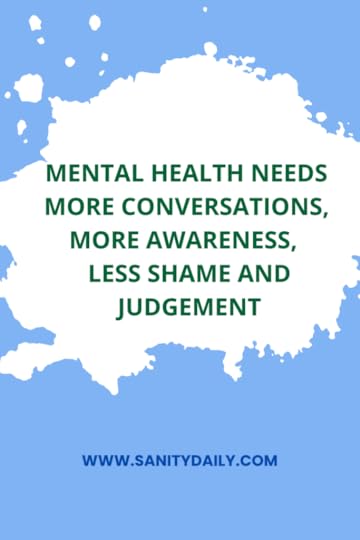 How did Writing for Mental Health and Self-Improvement help me to Become a Better Verison of ME?
How did Writing for Mental Health and Self-Improvement help me to Become a Better Verison of ME?Writing is cathartic and it also became my path to self-improvement, being completely from a non-psychological background, just to produce authentic and credible content, I did a full-time NLP practitioner course. I finished the Mindfulness practitioner course, and mental health first-aid course, not to become a counselor but to be able to be effective at what I do. To be able to answer anybody who would approach me with their problems, and it helped me.
I launched Sanity Daily in 2019, completely dedicated to talking about mental health, stress management, and self-improvement ways for the readers. It is said that sometimes you chose a career and sometimes the career chooses you, I found my life purpose in spreading awareness about mental and self-improvement ways. A passion-driven purpose keeps you moving ahead even if you don’t have anybody clapping for you and rooting for you.
In the process, I even learned SEO, and today at the age of 36, I am pursuing a full-time Master’s in Digital Marketing from a university in Scotland. Manging my little daughter and my content writing job all alone.
Perils of Choosing a Path and Saying” It’s My Choice”
I faced a lot of biasness and difficulty from the renowned writing platforms just because I chose to be a lone wolf, but this wolf was badly hurt and needed alone time to build herself, reflect, work on herself, and figure out many aspects of life, honesty still working on it. But, people usually go on your face (phase value) value and easily label you as a snob or an arrogant person.
I faced severe backlashes from one of my cousins, and one old friend when I chose this path because I started getting recognition, which left me wondering why. Fighting with each fear has made me the person that I am today, and dealing with my inner traumas alone has shaped me into this woman I am, and I will continue to travel on this path as long as I have strength.
I have chosen this path for myself and I trust the process, I will fail, I will cry, I will doubt myself, but I will get through the process and see that light shining bright towards the end of the tunnel 
“My message to anybody wanting to follow an unconventional path: If you believe in your idea, just go behind it, ignoring the background noise is not easy but the more you will start to travel to those lesser taken routes you will see the layers of fear, doubts, and dilemmas shedding from your soul. Build a strong belief system and have a clear intention. You will be there.“
Love and light!!
“This post is written for IT’S MY CHOICE Blog Train by Gleefulblogger & Wigglingpen in association with Vedix & Kerela Ayurveda“
8 Amazing Benefits of Practicing Yoga Nidra
Yoga Nidra is one of the most sought-after remedies today when it comes to correcting your sleep schedule. People who are leaning toward meditation and yoga definitely know what this is but if you’re looking forward to committing to better wellbeing, learn more about the benefits of Yoga Nidra before you start practicing it.
The constant stress and worries in life can make you twist and turn in your bed all night long. If you’re suffering from irregular sleep and anxiety, you’re not alone. Since most of the population is facing the same thing as you, it’s time you start paying attention to your physical and mental wellbeing. If achieving a good night’s sleep has become a distant dream for you, thanks to your worries, you need to indulge in Yoga Nidra.
What is Yoga Nidra?Yoga Nidra is a powerful technique of mind control that puts your body and mind into relaxation mode. It rewires your brain and gives you an extra time frame to get into a deeper state of relaxation.
 How to Practice Yoga Nidra?
How to Practice Yoga Nidra?It is very simple to perform Yoga Nidra. All you need to do is turn off the lights in your bedroom and keep your devices away from you, making sure there are no distractions. Lie down on your bed and start noticing the flow of energy in your body while focusing on your breath work.
8 Incredible Benefits of Yoga NidraImproves sleep: The mindful breathing technique that you practice will relax your body and calm your mind, putting you in a deep sleep. Practicing 30 minutes of Yoga Nidra will help you unwind from your everyday stress and ease your muscles, which will bring improved sleep. Reduces stress: Turn down your stress with Yoga Nidra where you will slowly enter into a state of being between wakefulness and sleepiness, but you won’t lose your consciousness. This state will release the happy hormones in your body, putting you at an ease.Connect with yourself: If you’ve lost a touch with yourself, engaging in Yoga Nidra will help you bring the lost connection back. Indulging in this form of meditation will help you acknowledge your emotions and also release unwanted, negative energy. Enhances self-love: Since you are able to relax better now, you will start appreciating the positive things in life. This positivity will lead to self-love, which will help you deal with problems in life with a happy face.Reduces chronic pain: This practice gives your body time to rest, heal and restore, which in turn brings down the inflammation and improves your bodily functions. Goodbye PMS symptoms: If you experience PMS or irregular periods, it’s time to bid them goodbye with this meditation. You will start noticing how you feel less agitated and your overall energy and mood improves.Detachment from your thoughts: As your mind begins to quiet, your thoughts will come and go before they eventually stop. You will realise the power of being still.You can enjoy life: Over time you will begin to see the world in a positive manner. You will draw strength and joy from your surroundings and learn to live in the present.Indulge in Yoga Nidra and reap its many benefits.
July 14, 2022
Encourage Employees To Travel For Wellness and Boost their Productivity
Corporate wellness can be expensive if the employees don’t have their health optimized. Beyond productivity, you want employees to get their much-needed rest to prevent burnout. Taking leave to travel is one of the best ways to get the most out of your human resources. Incentivizing wellness travel for employees can create a fantastic way to work and keep productivity at its peak. Here are a few ways to encourage employees to travel for wellness.
 8 Ways To Encourage Employees To Travel For WellnessMake Travel A Part Of Business Benefits
8 Ways To Encourage Employees To Travel For WellnessMake Travel A Part Of Business BenefitsIn a lot of companies, employees are confused about their benefits. Employers sometimes offer health, retirement, and insurance but fail to include more specific offerings. Wellness vacations, for example, aren’t usually included in benefits packages.
However, with a little bit of creative strategizing, you can incorporate it.
Third-party vendors can help set up and customize corporate travel plans. This could include everything, from paying for the flights to helping with visas. Therefore, the HR team has less to worry about and can focus on more critical business matters.
Customize Travel For Individual EmployeesNot all people have the same interests or needs. Every employee has different preferences when it comes to travelling. Some love adventure, some want to enjoy peace, and others want to do their sightseeing through culinary experiences. Further, some are looking for a quick trip, while others may wish for months.
While some may love adventure sports, others would instead relax on the beach. Some may want to explore new cultures, while others prefer home comforts. You must consider what your employees enjoy the most and plan activities accordingly.
For example, you could arrange group yoga sessions in a serene setting. Or organize a spa day. If you want to encourage physical well-being, you could go on a vacation with outdoor activities. Hiking, kayaking, and camping are all great options.
Use Incentives To Encourage ParticipationWhile making travelling a perk is excellent, it won’t mean anything unless people are excited about it. That’s why you need to give incentives. Create a contest where the winner gets a free trip. Or, give everyone gift cards for signing up. Make sure the prize is something they want.
When creating a program, consider offering incentives for employees who participate in company-sponsored trips. Incentivize your employees to take their leave and go around the world. Remind them that their travels will improve how they do their work.
Be Flexible With Your Vacation PolicyA lot of companies have strict vacation policies. They allow a certain number of days or require specific days off (like one weekend per month). If the idea of scheduling time off is stressful, then people will skip out on trips.
It’s essential to be flexible with these policies. If you have someone who wants to go away but can’t take a week off, try letting them go for a few days. Or, if you have someone interested in going, but doesn’t have the vacation time, let them come back early.
Create A Culture Of TravelingOne of the best ways to get people excited is to make it part of the company culture. Have a team-building retreat every quarter. You could even create a budget where the company pays for the travel expenses. This puts the responsibility of planning on the HR department, which frees them up for other duties.
Employees should feel excited when they return to the office from a trip. They should be able to share their experiences and encourage others to do the same. Remember, it’s human nature to retreat to your shell when you return from a holiday. So, creating a culture that encourages people to talk about their adventures is crucial.
By encouraging your workers to share their stories, you inspire them to continue exploring. They’ll feel like their office is a home away from home.
 Incentivize Healthy Travel Behaviors
Incentivize Healthy Travel BehaviorsHealth doesn’t just mean physical; It also means mental or emotional health for the people around you. A great way to support mental health is to promote positive behaviors. This can include everything from mindfulness, to eating well, to the proper organization.
Not all travellers are healthy. You want to ensure that employees will receive incentives for staying healthy during their travels whenever they travel. You could also reward people who exercise while travelling, keeping them fit.
You can incentivize these healthy practices by offering something in return. Get each employee a water bottle. Organize a yoga class once a month. Give bonus points for eating healthy. Encourage good eye care with eye drops to prevent blurred vision.
Offer TelecommutingIn addition to promoting a healthy culture, another way to encourage travel for good physical and mental health is to offer to telecommute. This gives remote team members more flexibility, giving them an excellent chance to travel wherever they want as long as they can connect with you.
Some managers may not like the idea of teams that are spread all over the world. But done right, it boosts productivity and increases job satisfaction.
One of the biggest obstacles to going on a work-related trip is that it requires travel and time. It can be challenging for professionals who live far from their workplace to find the time and resources to get away.
With telecommuting, the line between work and life is blurred. An employee can go on vacation but continue to work. They can even work through lunch. They can still check in with their team and get their work done. It allows them to experience the work-life balance they crave.
Sponsor Trips For Charitable CausesSponsoring philanthropic endeavours is a fun way to get your team members to participate in your health and wellness programs. You can sponsor a charity event or travel to another country to help out.
Depending on the cause, you can also invite people from other teams. This helps foster a sense of camaraderie among a variety of teams.
Some companies even let their employees choose their charity. When this is the case, it can improve team morale. The chosen charities might even align with what your company believes in.
Final ThoughtsIn today’s world, keeping employees happy and healthy is more important than ever. Encouraging employees to travel for wellness can do wonders for their physical and mental health.
A simple way to motivate your team to take more paid leave is by incentivizing them. You can do this simply by paying for travel costs, or you can do something more extravagant. Sponsoring a charitable endeavour, or organizing fun activities, are great ways to get the team to participate in its health benefits.
July 10, 2022
19 Effortless Ways To Practise Self-Love in Daily Life: 17th one is my personal favourite
What is self-love? What are the basic ways to practise self-love? How to practise self-love in daily life? From where does this term come into the picture? In our society, where no one demurs about how others feel, how can you make someone fall in life with themselves?
When I was young, (well, I am still young though) I use to show all the anger in the world to my body, I would stop eating, skip meals, I would stop decking up, would indulge in negative self-talk, what for? because someone scolded me, someone behaved badly or someone hurt me. And in turn, I ended up hurting myself even more. Do you know what is the crux of all this? Lack of attention, we all need that attention from someone at some point in time, but we forget to give attention to our body, mind and soul. Use self-love to do that.
Trust me, a very challenging path to cover and hence in this blog, I am going to talk about the importance of self-love and a few very basic ways to practise self-love and care in your daily life without going too far. Sounds fair and interesting? Let’s go!
What is self-love and what are the ways to practise self-love?Imagine you are a mother/father of a 5-year-old who knows nothing about the world but knows a little about his/her surrounding. Who completely is dependent upon you, trusts you and relies on you for every single thing, will you abandon that child?
Then why do you abandon yourself? That inner-self? The person compressed inside you, trapped in its own body beneath the layers of self-loathing and lack of self-awareness. Won’t you want to hug that child and tell him that it’s ok, it will be fine or whatever we are going through, it will pass?
This is love, this is care and affection. This is something you need to do with yourself, your inner child who seeks attention from no one else than you, who gives you warning signs and you ignore. Who alarms you by physical symptoms of your draining mental health but you ignore and then one day you face the burnout and everything breaks loose.
Can we prevent this? Can we minimise this or at least stay aware of our own situation? The answer is a big YES, but only if you are willing to. So hold yourself tight and drop all your ‘ifs’ and ‘buts’ before you read further because I am going to share some mind-blowing easy peasy ways to practise self-love.
19 Ways to practise self-love in your daily lifeWell, I said some, but here are 19 exclusive ways for you to practise self-love in your daily life. Owning our story and loving ourselves through the process is the bravest thing that we can ever do. I often get asked questions like how to practice self-love and care, how to love yourself and be confident and not feel guilty about it at the same time? I have formed a few self-love rituals in my daily life and I would love to share them with you.
1.) Self-love affirmations
To practise self-love you need to start showing some love to yourself through the words you use for yourself. Start developing a few positive affirmations and say them loud and clear to yourself daily.
2.) Replace your inner dialogue
The majority of the time we begin to curse ourselves when things go haywire, even when they are not in our control. Our inner dialogue is accusing and abusive to self, which needs to be replaced.
3.) Be mindful
I know it sounds cliche when someone asks you to be in the moment and go with the flow, but sometimes it is the wisest thing we can do for our sanity.
4.) It is ok to be imperfect
Perfection is like a work-in-progress. We all strive to be perfect but never acknowledge the raw imperfections of life. It is ok to be imperfect and do things at your own pace.
5.) It is ok to not have everything sorted at once
One of the most important ways to practise self-love is to also practise self-compassion, you cannot have answers to all the questions, or solutions to all the problems at once, you need to accept this and take things as they come.
6.) Take time for self-awareness
Your level of self-awareness helps you to set realistic expectations for yourself, the more you know your capacities and abilities to perform your duties and responsibilities, the more you are able to deliver efficiently.
7.) Reflect upon your circle
Your outer circle of friends and acquaintances has a lot to do with your inner circle, reflect upon your circle and set boundaries where needed.
8.) Do not indulge in gossip
How to practise self-love? by feeding your mind with positivity and beautiful things around, gossips and talking about others only leave a bad taste and we don’t want that negativity to enter into our body, let love reside.
9.) Personal care
Take time for personal hygiene, and for some rituals. I know some days are tough and you don’t want to do anything, you simply drag yourself but those are exactly the days when you need yourself the most, don’t leave that inner support by nourishing your body with love, care and some pampering.
10.) Do what you feel and when you feel
The more self-aware you will become the more you will be able to pick up tasks and responsibilities, take one task at a time, one day at a time and do things with 100% dedication, it will help you feel liberated.
https://anchor.fm/priyankajoshi/episodes/7-Ways-To-Stay-Self-Motivated-e1b9eio11.) Minimise content overload
Self-love also means refraining from garbage load. You must have heard about GIGA (Garbage In Garbage Out) with the content overload your mind becomes cluttered and you lose your own vision. (Well, blogs like these won’t harm)
12.) Be kind to yourself
I just treated myself with a jaffa cake, from time to time we put a lot of pressure on ourselves, sometimes we have to attend to guests, and do unplanned things and we lose track of our daily routine and work. It is usually overwhelming but at least we can be kind to ourselves in any way possible.
13.) Forgive yourself
It is ok to make mistakes, it is ok to goof up, and it is ok to not have everything sorted at once. Please learn to let go and forgive yourself for all these things.
14.) Don’t pressurise yourself
Another best way to practise self-love is to go easy and not pressurise yourself. We go so hard on ourselves to meet everybody’s expectations and fulfil our duties. Can we stop pressurising ourselves for all the things we already do?
15.) Do not set unrealistic goals
Know your body, know your capacity based on your present circumstances and then set goals. Do not overcommit to yourself, do not open 15 tabs inside your mind and jumble them all.
16.) Don’t be judgemental
We have society, friends and relatives to do that. At least you don’t judge yourself, doubt yourself and demean yourself for not doing things in a certain manner.
17.) Take a mental health day off
A much-needed off, we all deserve. Rather, mental health days should be made mandatory for all. A day in daily life routine where you are forced to relax and unwind from everything.
18.) Remember, Self-love is not being selfish
Self-love is preserving, self-love is caring for self and nourishing the internal injuries, it can never be selfish. to be able to fill others’ cups you need to re-fill your cup of joy and peace first.
19.) This shall too pass
When things go wrong, how does one practise self-love? By reminding, this shall too pass. Good times or bad times never stay too long, they just leave an impression of memories, lessons and experiences for us to cherish or regret. But these things are beyond our control, so hold on tight buddy, you got it.
To conclude, I would say practise self-love daily and only then you will experience the power of self-love. You will own everything yet nothing will own you, you will start freeing yourself from the unnecessary burden you have been carrying all your life. So do not fear falling for this new trend called “Self-love”.
Love and light

June 26, 2022
9 Easy Yoga Asanas for Mental Well-Being: Connect With Your Inner World Now
In this blog, I am sharing a comprehensive list of yoga asanas for mental well-being. Practising these basic and easy asanas will surely help you to boost your mental health.
I often hear people saying that it doesn’t work, we don’t get the time and it takes a lot of effort. Because we usually seek quick fixes and fast relief.
With the decreasing attention span and increasing intolerance, we are gradually heading towards a world full of restless minds and excessive stress. You can be anxious and confident at the same time, you can feel depressed and yet work at the same time, but you cannot be angry and level-headed at the same time.

The magical benefits of Yoga are known to the world. It is known to improve strength and flexibility and it also has immense benefits for mental health ranging from improving mood, and concentration, to relieving stress, and anxiety.
In my blogs, I often talk about reclaiming your lost inner space and I hardly skip mentioning the power of exercise, meditation, and mindfulness. Yoga is a discipline and it is for everyone who wants to make wellness a priority in their lives.
Now with wellness, we often stress over losing weight or gaining strength which is also a good thing but what we miss out here is the weight we need to lose first, which is the weight of loads of accumulated stress, piled-up responsibilities, and duties, lack of managing expectations and unfulfilled goals.
Now the million-dollar question, how can practising yoga asanas for mental well-being help you develop equanimity? Yoga has properties of both the physical fundamentals of humanity and spiritual uplift. A classic blend of knowledge, karma, and devotion. It can help you to disengage from external factors that cause stress to you.
9 Easy Yoga Asanas for Mental Well-Being you must tryNow before you begin, let me tell you you don’t have to be a yogi or yogini to reap the benefits of yoga. Yoga is an effective tool to calm the mind and strengthen the body, irrespective of your expertise level, your gender, and age.
Also, keep it as simple as possible, create your own atmosphere, and don’t be intimidated by the fancy yoga studios and stress over complicated poses. Yoga is for everyone. Here is a list of 9 easy yoga asanas for mental well-being:
Disclaimer: It is important to consult your physician before beginning yoga if you have never done it before and also if you suffer from some underlying illness. Make sure that your bowels and stomach are empty before you perform any asana. It might be a good idea to give a gap of a few hours between your last meal and the exercise.
1.) Chandra Namaskar 2.) Chakrasana3.) Adho Mukha Asana4.) Paschimottanasana5.) Prasarita Padottasana6.) Balasana7.) Viparitasana8.) Halasana9.) Savasana1.) Chandra Namaskar (Moon Salutation)
You must be well aware of sun salutation, but we hardly talk about moon salutation. Like sun salutation, each step is coordinated with breathing. The difference between moon salutation (yin) and sun solution (yang) is that the latter is about the heat, light, and activity in our lives, and the former is about calmness, cooling-off, and meditation.
Moon Salutation for mental health:
Moon Salutations are used to calm the mind and draw your awareness inward. It helps you in channelizing the lunar energy; which has cool, relaxing, and creative qualities. The best part about Moon Salutation is that the slow stretches allow you to connect with each part of your body and bring your maximum awareness to it. It stretches the spine, hamstrings, and backs of the legs; strengthens the leg, arm, back, and stomach muscles.
2.) Chakrasana (Wheel pose)
Chakrasana is extremely beneficial for those who usually hunch over the desk all day long. The backward bend in the pose will relieve tension or stress from the body and help in decreasing the ailments arising out of it. One of the best yoga asanas for mental well-being is also helpful in strengthening and toning your muscles.
Chakrasana for mental health:
Chakrasana relieves you from anxiety, stress, and other emotional problems rewarding you with good mental hygiene. Here is how; while you perform Chakrasana the blood is directly flowing to the brain cells oxygenating them. It not only rejuvenates you physically but also recreates the scope of filling you with immense peace reconnecting you with your inner self.
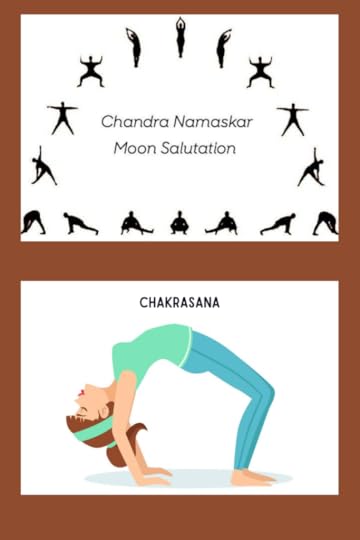
3.) Adho Mukha Asana (Downward-Facing Dog)
Adho Mukho Asana is very easy to follow and is a part of many sequencing exercises too. This asana has numerous amazing benefits that make it extremely essential for you to practice it every day. The best part is, that even a beginner can get the hang of this asana with great ease.
Adho Mukha Asana for mental health:
Adho Mukha asana helps in reducing anxiety by helping you relax and calm down. In this pose, as the neck and cervical spine are stretched, stress is released from the muscles. The stretching through the pose releases endorphins that help relax your body and mind.
4.) Paschimottanasana (Seated Forward Bend)
One of the best yoga asanas for mental well-being, as it provides a deep stretch to our entire body. It is very effective for people suffering from various blood and glands-related disorders such as high blood pressure and diabetes.
Paschimottanasana for mental health:
Paschimottanasana helps to relieve mental and physical stress thereby calming the body and mind. It stimulates a smooth flow of blood to the entire body thereby energizing the cells of the whole body, especially the mind. Proper blood circulation relaxes the body and mind which in turn helps one in reducing mental ailments like stress, insomnia, and other such disorders.
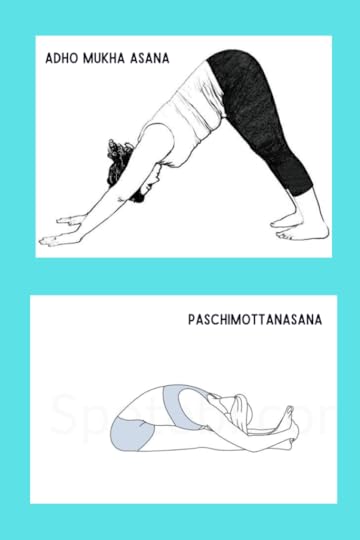
5.) Prasarita Padottasana (Wide Stance Forward Bend)
Prasarita Padottanasana is an energized version of yoga that helps in increasing blood circulation to the brain while stretching the legs, arms, and back of a person.
Prasarita Padottasana for mental health:
Prasarita Padottanasana is an easy and effective pose for letting go of symptoms of anxiety and mild depression. This practice energizes and reduces fatigue. In addition to the mental benefits, physically the pose uses your body weight to release tension in the back, while also providing a nice stretch to the hamstrings and calves.
6.) Balasana (Child pose)
Balasana is a forward kneeling asana in modern yoga as exercise. It is very easy and can be practised by anyone. Balasana is performed preceding and following various asanas including Sirsasana as it is a resting pose.
Balasana for mental health:
It is a very effective pose for relieving anxiety and restlessness. It helps you to calm down as you kneel in this asana with your closed eyes. It helps in releasing the tension in the back, spine shoulders, and chest.
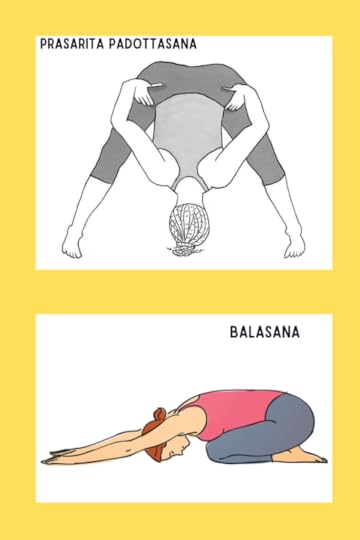
7.) Viparitasana (Legs up the wall pose)
This one is my daughter’s favourite, although she does it for fun along with me, the benefits are cathartic. It is one of the most effective yoga asanas for mental well-being. It is done fully supported pose using a wall and sometimes a pile of blankets.
Viparitasana for mental health:
Viparitasana is a simple but effective anxiety-alleviating yoga that helps relax and calm the mind and stimulates the nervous system. It also regulates blood flow and is helpful in treating depression and insomnia.
8.) Halasana (Plough Pose)
Halasana may look slightly difficult but is super effective in calming your brain and therapeutic for your back. An inverted pose would require you to keep your hands on the floor, raise your legs and place them right behind your head.
Halasana for mental health:
Halasana strengthens and opens up the neck, shoulders, abs, and back muscles. It is very helpful in calming the nervous system, eventually reducing stress and fatigue. Besides this, it is helpful in strengthening the immune system and improving flexibility.
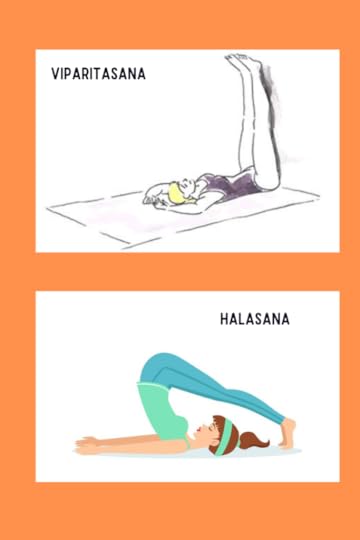
9.) Savasana (Corpse Pose)
Last but not the least, never underestimate the power of one of the easiest yoga asanas for mental well-being anybody can do, but hardest among all because you just have to lie down and bring all your awareness to your body. In hatha yoga and modern yoga, Savasana is often used for relaxation at the end of a session. It is the usual pose for the practice of Yog Nidra meditation.
Savasana for mental health:
Practising Savasana relieves physical and mental stress that builds during a workout session. It puts your body to rest after the rigorous stress your body goes through after a strict exercise routine. It brings back the body balance by allowing it to rest by focusing on the flow of your breaths.
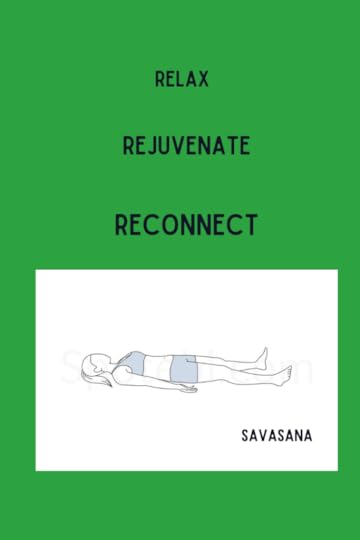
In the end, I would say that doing a few forms of asanas on a regular basis has been shown to enhance brain wave coherence and improve functions such as memory and intelligence. It has been ages since people practice restorative Yogasanas and have benefitted in their life.
When you can not go outside, you can always turn inside and work on your internal repair, which will ultimately help you to build resilience for the coming future. Stay safe, stay healthy, and stay fit. Rise up!
Love and light!
June 20, 2022
The Incredible Benefits of Practising Self-Awareness in Daily Life
Thinking about self is not equal to knowing self. Practising self-awareness in daily life is a way toward knowing yourself a little more each day with every passing life experience. We think we know a lot about ourselves, the problem is we ‘think’, do we actually know our inner ability and do things based on our set internal standards?
Self-awareness is your ability to understand your actions and reactions based on your thoughts and emotions. Things you can do and cannot do, duties you can perform and you cannot perform. The more self-aware you are the more you are able to manage expectations and communicate your thoughts in a much better way.
Practising Self-Awareness in Daily Life: Reasons and BenefitsNo matter how hard we try we cannot escape from our thoughts and feelings, there is so much hidden beneath the layers inside us. The more I sit with myself, the more I dwell on the possibility of knowing myself. What else I can discover? And what else I can do based on my discoveries? The possibilities are limitless, but only if you are willing to be mindful and receptive to the outcome.
In the process of practising self-awareness in daily life, you might come across many limitations which will leave you rattling and loathing. You might even think, WHY me? We all do this, but as soon as you will start replacing the WHYs with WHATs you will begin to experience the life-changing outcomes in your daily life.
You can begin by, replacing, WHY is this happening to me? with, WHAT can I possibly do to overcome it?
Replacing why’s with what’s gives you clarity in thoughts and makes you solution-focused and not problem-focused.

Benefits to becoming more self-aware:
Being an NLP practitioner, I suggest you undertake this Self-Awareness Test to develop an understanding of yourself. When we practise self-awareness in daily life, we see ourselves clearly, we make better decisions, we are more confident and we communicate effectively. When we know our strengths and weaknesses as a result of deep introspection and self-reflection we perform better at work. Here are a few benefits of practising self-awareness in daily life:
+ Improved life skills by recognizing what you do well and what you need to improve
+ Increase in your happiness levels by aligning your ideals with your actions
+ Improved leadership skills by understanding how employees/co-workers perceive your behavior
+ Strengthened work and personal relationships by managing emotions
+ Increased self-motivation by seeking out your true passions
+ Decreased stress by identifying your emotions and decluttering tasks you don’t enjoy.
Self-awareness is also helpful when:
+ Working with others in a team
+ Coping with stress
+ Dealing with change
+ Managing and leading others
+ Dealing with clients
1.) Explore your feelings: Stop ignoring your feelings, explore them.
2.) Track your habits: Make a habit of tracking your feelings. Keeping a journal is one method, and it can be helpful to write about your thoughts, feelings, successes, and failures each day.
3.) Self-reflection will allow you to better understand yourself.
4.) Ask for feedback: Ask for feedback from your friends, family, and colleagues, and take personality tests. Often, we are not aware of certain aspects of our personality, creating blind spots in our self-awareness.
To conclude, I would say many individuals find it really hard to accept the consequences of the choices they make in their daily lives, but with our level of awareness, we can not only take much more calculative decisions but can also enable our minds to be ready to face any consequence and work towards finding alternatives. We all need a level of awareness that can help to significantly boost our overall quality of life.
Additional Resources
Increase your self-awareness with one simple fix | Tasha Eurich | TEDxMileHigh – HereHarvard Business Review – Here A longitudinal, mixed method evaluation of self-awareness training in the workplace. 2015 study by Sutton, Williams, and Allinson – Here Personality test- 16 PersonalitiesLots of love and gratitude




